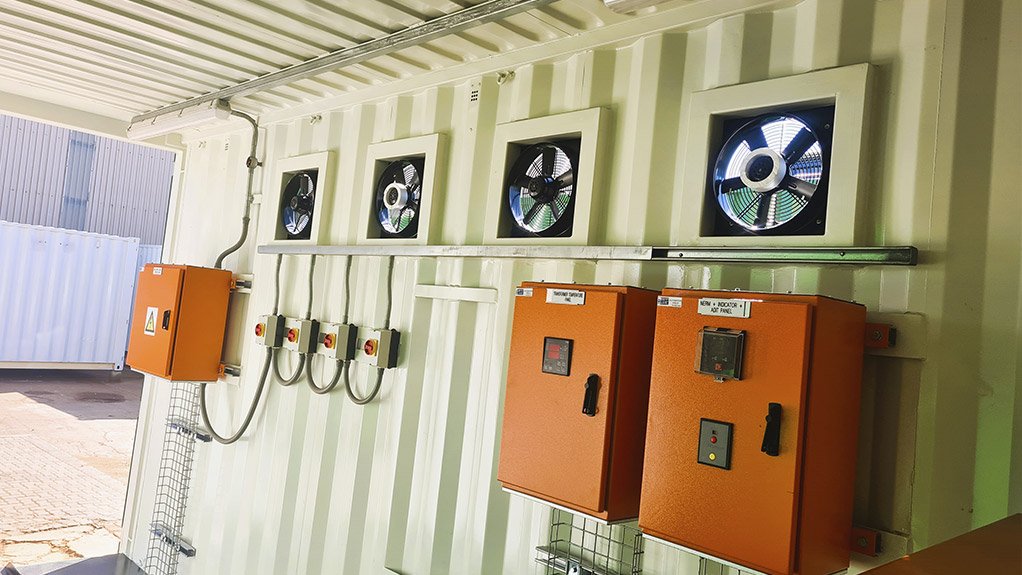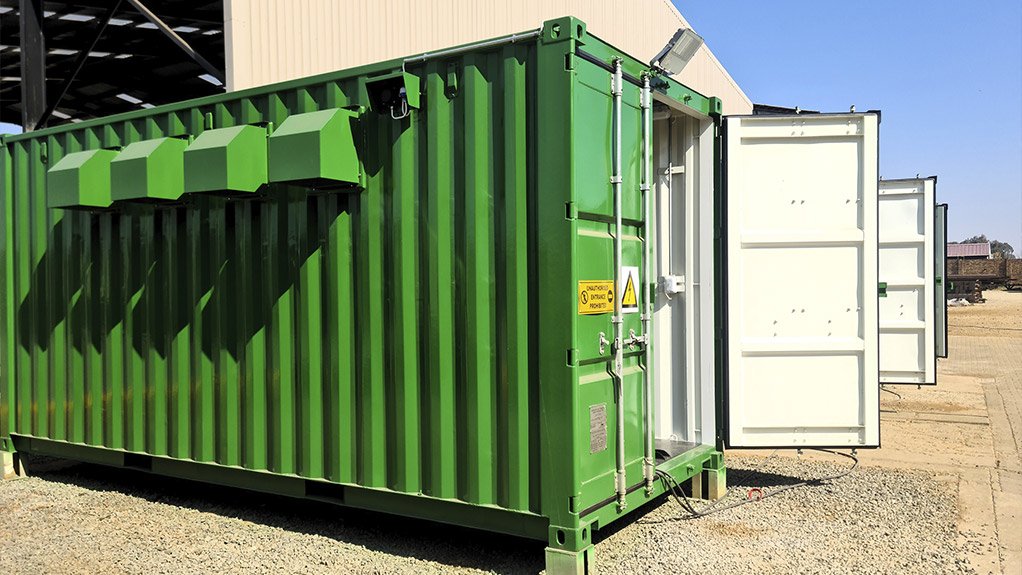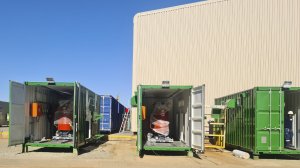Modular substations and dry-type transformers pave the way for renewable energy growth in Africa




E-House fitted with monitoring control panels specially for a renewable energy application
Positioning of the dry-type transformer in the E-House
For this renewable energy application, the E-House is equipped with a heat exchanger and extraction fans ensuring the correct temperature is adhered to
This article has been supplied as a media statement and is not written by Creamer Media. It may be available only for a limited time on this website.
The growing renewable energy generation sector in Africa is realising the value of modular substations in solar and wind projects, as well as the suitability of dry-type transformers in these installations.
According to David Claassen, Managing Director of Trafo Power Solutions, solar photovoltaic and wind farms have an important characteristic in common: they both have to deal with multiple sources of generated energy. At a solar plant, for instance, there is a large area of solar panels – especially when the project is of utility scale – that require many individual substations at different locations within the project.
“Depending on the output of the plant, it could require 30 to 100 substations to service the generation capacity,” says Claassen. “This means that there is a large volume of essentially identical substations, which lends itself to factory-based production. In this way, projects gain the quality benefit of dedicated workshop conditions, as well as the cost benefits related to economies of scale when it comes to sheet metal, structural steel and other components.”
When production is streamlined in this way, the completion of the units is also quicker, he says, and is likely to be accomplished by a smaller team than would be required to build brick-and-mortar structures on a distant site. He noted that the locations chosen for these renewable projects – especially for wind farms – are invariably in quite remote areas, making logistics challenging.
The usual inputs for on-site construction such as water, sand and aggregate are often difficult to find nearby, and can be costly to transport. The best places to generate energy from wind turbines are frequently to be found in hilly or mountainous areas, and there is usually little infrastructure to support the early on-site operations.
“We have seen many of South Africa’s solar and wind power projects already incorporating this modular approach to inverters,” he says. “As a supplier of modular substations, we also specialise in dry-type transformers which are well-suited to these applications.”
He highlights that dry-type transformers fit easily into compact modular substations along with the inverter, switchgear and ancillary equipment. Perhaps most importantly, the design and operation of these transformers aligns closely with the sustainability philosophy that underpins the promotion of clean, renewable energy.
“It makes sense for renewable energy projects, who are leading the charge to supplement and eventually replace fossil fuels, to employ technologies that do not rely on oil,” explains Claassen. “Unlike conventional transformers, which are cooled by oil, dry-type transformers are air-cooled and are much more environmentally friendly.”
The absence of oil as a coolant means that there is no risk of oil contamination through leakage, and much higher levels of safety. The safety ranking of dry-type transformers allows them to be situated close to human traffic and even indoors – as there is little danger of fire or explosion.
With most of these renewable energy projects being driven and funded by independent power producers (IPPs), the cost per kilowatt-hour is paramount to their success. They are generally selling their electricity at a pre-agreed price to a utility or customer, so they need to carefully control their capital and operating expenditure.
“While the manufacture of substations in a modular format saves them on the upfront capital, the dry-type transformers require minimal maintenance and save on the plant’s running costs,” he says. “In contrast, oil-cooled transformers need to be regularly inspected and the oil must also be changed; on renewable projects where there could be 100 of these units to be maintained, there are substantial costs involved.”
There are other important technical reasons why dry-type transformers are the best choice for renewal power applications. Claassen explains that it is vital for transformers to be purpose-designed, and in the case of solar plants especially, there are high ambient temperatures to be considered in the design. The cooling system must be capable of managing the heat, so that the performance and service life of the transformer is optimised.
“Within our design for modular substations in the renewable energy space, we have multiple options for cooling, depending on the prevailing conditions,” he says. “This includes naturally ventilated air, forced ventilated air or cooling strategies using heat exchangers based on either air or water.”
He notes that Trafo Power Systems’ transformer units for these applications are rated as Class H on both the low voltage and medium voltage windings.
“Another key aspect of the design is the fact that transformers in a photovoltaic application experience a daily cycle of full load and no load, so there is frequent expansion and contraction of the windings that needs to be accommodated,” he says. “Further to that is the non-linear supply from the inverter, so the transformer has to be designed for high harmonic content, which also translates into a temperature consideration.”
He emphasises that Trafo Power Systems has extensive in-house design experience to meet these requirements, and project management expertise for engaging effectively with clients, engineers and other stakeholders on each project.
“In summary, it is crucial that wherever substations and transformers are supplied to renewable energy projects, the designers have a thorough understanding of thermodynamics,” says Claassen. “There is a considerable risk of poorly designed units overheating due to operating outside of their design limits; if all the project parameters are not fully considered, the results can be catastrophic.”
Comments
Press Office
Announcements
What's On
Subscribe to improve your user experience...
Option 1 (equivalent of R125 a month):
Receive a weekly copy of Creamer Media's Engineering News & Mining Weekly magazine
(print copy for those in South Africa and e-magazine for those outside of South Africa)
Receive daily email newsletters
Access to full search results
Access archive of magazine back copies
Access to Projects in Progress
Access to ONE Research Report of your choice in PDF format
Option 2 (equivalent of R375 a month):
All benefits from Option 1
PLUS
Access to Creamer Media's Research Channel Africa for ALL Research Reports, in PDF format, on various industrial and mining sectors
including Electricity; Water; Energy Transition; Hydrogen; Roads, Rail and Ports; Coal; Gold; Platinum; Battery Metals; etc.
Already a subscriber?
Forgotten your password?
Receive weekly copy of Creamer Media's Engineering News & Mining Weekly magazine (print copy for those in South Africa and e-magazine for those outside of South Africa)
➕
Recieve daily email newsletters
➕
Access to full search results
➕
Access archive of magazine back copies
➕
Access to Projects in Progress
➕
Access to ONE Research Report of your choice in PDF format
RESEARCH CHANNEL AFRICA
R4500 (equivalent of R375 a month)
SUBSCRIBEAll benefits from Option 1
➕
Access to Creamer Media's Research Channel Africa for ALL Research Reports on various industrial and mining sectors, in PDF format, including on:
Electricity
➕
Water
➕
Energy Transition
➕
Hydrogen
➕
Roads, Rail and Ports
➕
Coal
➕
Gold
➕
Platinum
➕
Battery Metals
➕
etc.
Receive all benefits from Option 1 or Option 2 delivered to numerous people at your company
➕
Multiple User names and Passwords for simultaneous log-ins
➕
Intranet integration access to all in your organisation




















